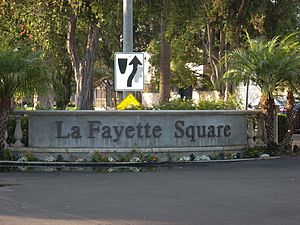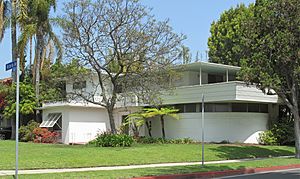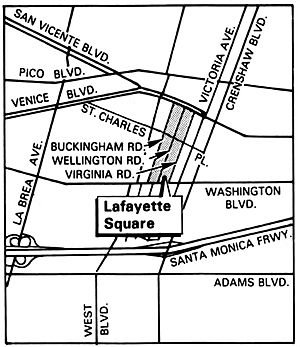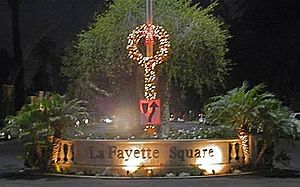Lafayette Square, Los Angeles facts for kids
Quick facts for kids
LaFayette Square
|
|
|---|---|

The LaFayette Square neighborhood sign at St. Charles Place, around 2015
|
|
| Country | |
| State | |
| County | |
| Time zone | Pacific |
| Zip Code |
90019
|
| Area code(s) | 310/424, 323 |
LaFayette Square is a special historic neighborhood in the central part of Los Angeles, California. It's known for its beautiful old homes and unique history.
This neighborhood was started in 1913 by a real estate developer named George L. Crenshaw. He named it after the French Marquis de Lafayette, a hero who helped the American colonists during the American Revolution. LaFayette Square is located west of Crenshaw Boulevard in the Mid-City area. In 2000, the city officially recognized it as a Los Angeles Historic Preservation Overlay Zone. This means its important buildings and history are protected.
Contents
History of LaFayette Square
How the Neighborhood Began
The land where LaFayette Square now stands was once part of a large vineyard (a place where grapes are grown). It was located between Washington and Sixteenth streets, just west of Crenshaw Boulevard. In 1913, properties in this new area went on sale.
LaFayette Square was the last and biggest housing project by banker George L. Crenshaw. The neighborhood has four streets that run north to south, with a grassy area in the middle that runs east to west. Any land that wasn't sold by early 1920 was then sold off.
Building a Bridge for Safety
In 1915, people living in LaFayette Square asked the city to build a flat road crossing over the Pacific Electric train tracks. They said that without it, children had to walk two miles to school. Stores also found it hard to deliver goods because of the long detour.
However, the city's Public Utilities Board decided against a flat crossing. They said it would be the most dangerous "death-trap" in the city. Instead, they approved plans for a more expensive viaduct. A viaduct is like a bridge that carries a road over something else, like train tracks.
The City Council agreed to build the viaduct, which cost $40,000. The Pacific Electric company paid half, and the city and property owners paid the rest. The viaduct was built in 1920. This new bridge made it much safer and easier for people to get to Los Angeles High School. It also gave them direct access to areas like West Hollywood and Beverly Hills.
Adding Gates for Privacy and Safety
Around 1980, the LaFayette Square Association suggested closing off the neighborhood entrances. They wanted to block the ends of the streets to create cul-de-sacs (streets with only one way in and out). Neighbors talked about how this might affect crime, traffic speed, and how emergency vehicles could get in. In 1989, the Los Angeles City Council approved the idea.
In the early 1990s, beautiful wrought-iron gates were put up at the ends of Buckingham Road, Virginia Road, Wellington Road, and Victoria Avenue. Now, the only way to drive into the neighborhood is through St. Charles Place. To pay for these gates, each homeowner paid $40 per year for 10 years.
Exploring LaFayette Square's Location
LaFayette Square is located about 7 miles (11 kilometers) west of Downtown Los Angeles. It sits south of Victoria Park, east of Arlington Heights, and north of Wellington Square.
The neighborhood is made up of eight blocks. It's centered around St. Charles Place. Its borders are Venice Boulevard to the north, Washington Boulevard to the south, Crenshaw Boulevard to the east, and West Boulevard to the west. There are 236 homes in this special neighborhood.
Homes in LaFayette Square
LaFayette Square was designed for wealthy families. Many of the historic houses are very large, often between 5,000 and 6,000 square feet (about 460 to 560 square meters). The average home size is about 3,600 square feet (about 330 square meters).
These homes often have amazing original details. You might find Juliet balconies, grand mahogany staircases, libraries, sitting rooms, and beautiful stained glass windows. They also feature fancy triple crown molding, very tall ceilings, and sometimes even garages big enough for four cars!
Who Lives in LaFayette Square?
The types of people who owned homes in LaFayette Square changed over time. From the 1920s to the 1940s, only white people could own homes due to old rules. But in the 1950s, court decisions made these rules illegal. After that, almost all the homeowners were African American.
In the early 1990s, the community started to become more mixed. More white families, who found homes too expensive in areas like the Westside and Hancock Park, began moving back to LaFayette Square.
Schools in the Area
Students living in LaFayette Square attend schools within the Los Angeles Unified School District. These schools include:
- Alta Loma Elementary School
- Johnnie L. Cochran Jr. Middle School (which used to be called Mount Vernon Middle School)
- Los Angeles High School
Famous People Who Lived Here

Many well-known people have lived in LaFayette Square over the years. Here are some of them:
- William Claude Dukenfield, known as W.C. Fields (1880-1946), a famous actor.
- George Pepperdine (1886-1962), a businessman and generous person who started Pepperdine University.
- Roscoe Conkling Arbuckle, known as Fatty Arbuckle (1887-1933), an actor.
- Paul R. Williams (1894-1980), a very important architect.
- Norton Simon (1907-1993), a famous art collector.
- Joseph Louis Barrow, known as Joe Louis (1914-1981), a legendary boxer.
- Vaino Spencer (1920-2016), a lawyer and judge.
- Paul Younger Tank Younger, (1928-2001), a football player.
- Richard Wayne Penniman, known as Little Richard (1932-2020), a groundbreaking musician, singer, and songwriter.
- John Roseboro (1933-2002), a baseball player and coach.
- Larry McCormick (1937-2004), an actor, reporter, and news anchor.
- John Mack (1937-2018), who led the L.A. Urban League.
- Mahdi Abdul-Rahman, known as Walt Hazzard (1942-2011), a basketball player and coach.







